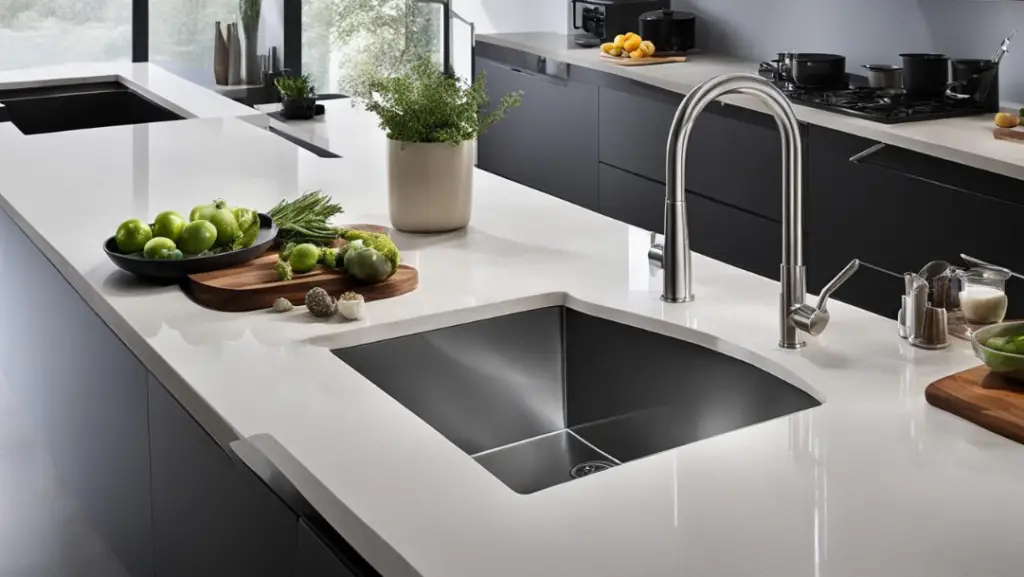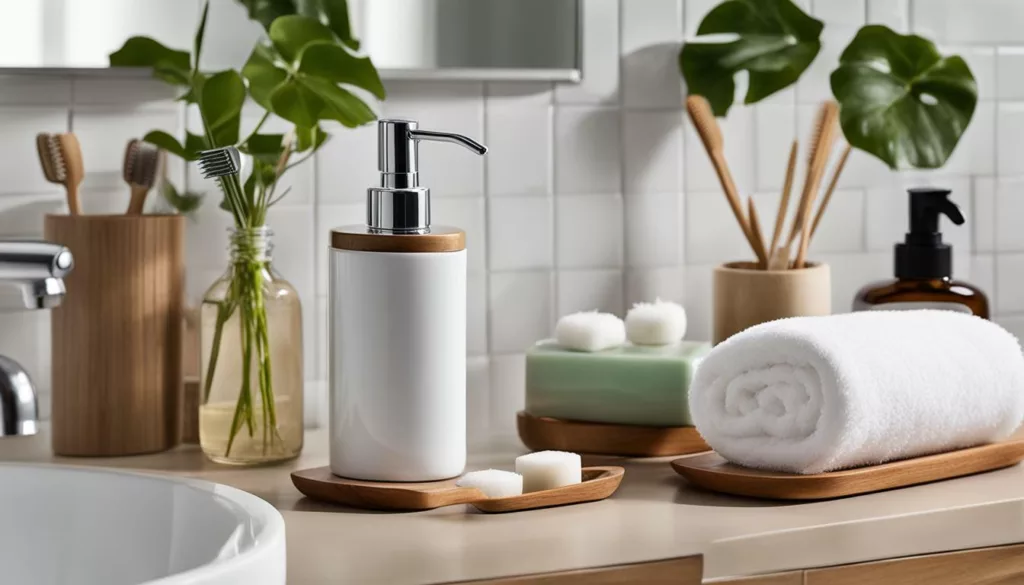Kitchen Sink Types
Choosing the right kitchen sink is an important decision when remodeling or building a new home. With so many sink types available, it can be challenging to determine which one is right for you. That’s why we’ve created this comprehensive guide to explore 10 different kitchen sink types and discuss their pros and cons. By understanding the advantages and disadvantages of each sink type, you can make an informed decision that suits your needs and preferences.

Key Takeaways:
- There are 10 different kitchen sink types to choose from.
- Each sink type has its unique advantages and disadvantages.
- Factors to consider when choosing a sink include installation ease, cleaning convenience, space requirements, and overall aesthetics.
- By understanding the pros and cons of each sink type, you can make an informed decision that suits your specific needs.
- Ultimately, the right sink type for you will depend on your priorities, whether they be functionality, style, or a combination of both.
Top-mount, Drop-In, or Self-Rimming Sink
If you want a sink that’s easy to install and replace, a top-mount sink (also known as a drop-in or self-rimming sink) may be your best option. With this type of sink, you simply drop it into the countertop opening. The sink has a visible rim that rests on top of the counter.
While top-mount sinks offer some benefits, such as easy installation and replacement, they also have some downsides. One of the main disadvantages of this sink type is that the rim can accumulate dirt and grime, making cleaning a bit more challenging compared to other sink types.
If you’re considering a top-mount sink for your kitchen, here are some pros and cons to keep in mind:
| Pros | Cons | |
|---|---|---|
| Easy to install | – Can be replaced without difficulty – No need for special modifications to the countertop |
– Rim can trap dirt and grime, making cleaning more challenging – Rim can collect moisture, which can lead to mold and mildew |
| Relatively inexpensive | – Top-mount sinks are generally more affordable than other types of sinks | – Limited designs and styles available – Visible rim may not be aesthetically pleasing to some homeowners |
| Durable | – Top-mount sinks are typically made from durable materials such as stainless steel | – Rim can chip or crack over time, which can compromise the sink’s integrity |

“If you’re looking for an easy-to-install and affordable sink option, a top-mount sink may be a good choice. However, keep in mind that the rim design can make cleaning more difficult.”
Undermount Sink
When it comes to achieving a sleek and modern look in your kitchen, the under-mount sink is a top choice. This sink type is installed underneath the countertop, creating a seamless appearance with the counter surface. One of the main advantages of an under-mount sink is easy cleaning, as there is no rim to catch debris, making it a hygienic choice for busy kitchens.
However, there are also a few drawbacks to consider. Undermount sinks require professional installation since they need to be securely glued to the counter underside. This can make them more expensive than top-mount sinks, which are easier to install. In addition, if the sink is not well sealed during installation, it can lead to water damage to the surrounding countertop area.

“Undermount sinks create a seamless look that is highly desirable among homeowners. They’re perfect for marble, granite, or quartz countertops.”
Double Basin/Bowl Sink
A double basin or double bowl sink is a popular choice for many homeowners as it offers more versatility in the kitchen than a single basin sink. With two separate compartments, you can easily multitask by washing dishes in one basin while rinsing fruits and vegetables in the other. However, there are both pros and cons to consider when choosing a double-basin sink.
Pros:
- Allows for multitasking in the kitchen
- Separate compartments provide more organization and flexibility
- Minimizes cross-contamination between food and dirty dishes
Cons:
- The divider between the two basins can limit the space available for larger items
- Cleaning larger pots and pans may be more challenging due to the divider in the center
When deciding whether a double basin sink is right for you, consider your household’s needs and preferences. Do you frequently cook large meals that require cleaning oversized pots and pans? If so, a single-basin sink may be easier to work with. On the other hand, if you often multitask in the kitchen, a double basin sink may make meal prep and cleanup more efficient.

Single Basin/Bowl Sink
A single basin or single bowl sink provides ample space to wash larger items, such as pots and pans. With no divider, this sink type delivers the flexibility to accommodate items of various sizes and shapes.
One of the downsides of a single basin sink is that multitasking can be challenging, as there is only one compartment to work with. If you need to wash dishes while rinsing fruits and vegetables, you may need to switch tasks frequently.

“Single basin sinks are perfect for those who need extra space to wash larger items but don’t mind sacrificing multitasking capabilities,” says John Smith, a kitchen design expert at Smith’s Kitchen.
Farmhouse or Apron Sink
If you’re aiming for a rustic look in your kitchen, a farmhouse or apron sink might be the perfect fit. Its exposed front panel extends slightly beyond the edge of the countertop, adding a charming touch to your kitchen’s design.
In addition to its aesthetic appeal, a farmhouse sink provides ample space for washing large pots and pans. However, it’s important to note that this type of sink requires special cabinetry modifications to accommodate its size, which can increase its cost.
| Pros | Cons |
|---|---|
| Provides ample space for washing larger items | Requires special cabinetry modifications to accommodate sink size |
| Adds a rustic and charming touch to the kitchen | Can be more expensive than traditional sinks |
Overall, a farmhouse sink is an excellent choice if you’re looking for a unique and rustic addition to your kitchen. However, be sure to consider the extra cost and required modifications before making your final decision.

Drainboard Sink
A drainboard sink merges a practical draining area alongside the primary sink bowl, which eliminates the need for a drying rack and makes air-drying dishes more convenient. While it offers excellent functionality, it does require slightly more counter space than traditional sink models. Consequently, they may not be the best option for smaller kitchens with limited surface areas.

Pros and Cons
| Pros | Cons |
|---|---|
| – Built-in Drainboard | – Takes up More Counter Space |
| – More Convenient and Practical than Drying Racks | – May not be Suitable for Smaller Kitchens |
Low Divider Double Basin Sink
A low divider double basin Kitchen Sink Types is a popular choice these days, and it’s easy to see why. With a lowered divider between the two compartments, this sink type creates a larger and more versatile workspace that makes tasks such as washing large pots and pans easier. The lower divider also doesn’t block the flow of water, allowing you to move the dishes and utensils around without any obstruction.
However, one potential downside to this type of sink is that the lower divider can limit the water depth in each basin, making it challenging to fill larger pots and pans. Additionally, while the separation is enough to minimize cross-contamination, it’s not as effective as a high divider in minimizing it entirely.

If you’re considering a low divider double basin Kitchen Sink Types, here are some pros and cons to keep in mind:
Pros:
- Provides a larger and more versatile workspace
- Allows for easier handling of larger items
- Less obtrusive than a high divider
Cons:
- Can limit water depth, making it difficult to fill larger pots and pans
- May not be as effective as a high divider in minimizing cross-contamination
Conclusion
Choosing the right Kitchen Sink Types is a crucial decision when planning or remodeling a kitchen, and we hope this guide has provided valuable insights into the pros and cons of 10 different types of kitchen sinks.
Remember to consider factors such as installation ease, cleaning convenience, space requirements, and overall aesthetics before making a final decision.
Whether you prioritize functionality style, or both, there is a kitchen sink type that will be perfect for your home. So go ahead and choose the one that best suits your needs and preferences.
With the right Kitchen Sink Types, you can ensure that your kitchen serves not only as a functional cooking space but also as an aesthetically pleasing one, adding value to your home for years to come.
Happy Learning
Also, Read,
How To Unclog A Kitchen Sink Effectively
12 Easy Steps to Unclog a Toilet



